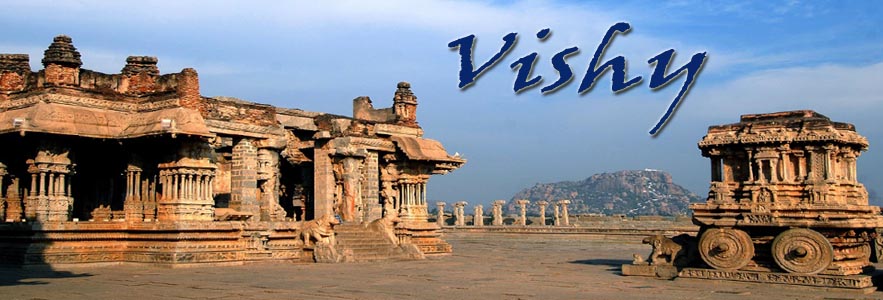The main temple at Nanjangud is dedicated to the Hindu God Shiva, also called Nanjundeshwara, "The God who drank poison". In Hindu mythology, the Gods and demons churned the ocean in search of the ambrosia. During this churning, poison emanated first, followed by ambrosia. To prevent the poison from spreading across the universe and to destroy it, Shiva came to the rescue and drank it up. His wife Parvati then held his throat tightly to prevent the poison from spreading to the rest of his body and killing him. Narada held his mouth so that he did not vomit it out. The poison remained in his throat, making it blue in colour. For this reason, Shiva is also called Neelakantha, or "the blue-thorated one". Nanjanagud literally means "the place where Nanjundeshwara resides."
The town is famous because of the huge temple dedicated to Lord Nanjundeswara also referred to as Srikanteswara. It is believed that sage Gauthama stayed here for some time and installed a Lingam, the idol form of Shiva. Nanjangud is also known as Dakshina Kashi or Varanasi of the South.
The temple was originally built by the Ganga rulers in the 9th century during their occupation of this region. The residing deity of the temple was later called Hakim Nanjunda; as given by the Tippu Sultan as it is said a favorite elephant of his was cured after prayer was offered to the deity. The same story is attributed to Hyder too ( as per Mysore Gazetteer)! It is said and inscribed in the temple history that his favourite and beloved elephant was bestowed with eyesight by the Lord, after Tippu Sultan's vow with the local deity. The Sultan then had a Lingam made of jade along with an emerald necklace and donated it to the temple. The Vaidya Nanjundeswara, even today is said to be a healer for his believers, and one can see even today worshippers doing Urulu seve, a ritualistic practice after taking bath in the Kapila river.
Twice every year thousands of worshippers gather for the famous Chariot Festival locally known as the Dodda Jathre and the Chikka Jathre. Idols of Lord Srikanteshwara, Goddess Parvathi, Lord Ganapathi, Lord Subramanya and Lord Chandikeshwara are kept in five separate chariots and a traditional puja is performed to the idols early in the morning on the Jathre day. After the puja chariots are flagged off. Thousands of devotees pull the Chariots carved out of wood, across the streets of the old town. The town remains immersed in festivities on the Jathre days.
The very famous Sree Srikanteshwara Suprabhata Stotram was composed by Veda Brahma. Turuvekere Subrahmanya Vishweshwara Dikshith also known as Sri. T. S. Vishweshwara Dikshith. Veda. Brahma. T. S. Vishweshwara Dikshith was born in Turuvekere, a small town in Tumkur district and was the Sanskrit professor in Maharaja Sanskrit College in the Royal Kingdom of Mysore and resided at Mysore. He was also the Aasthana Vidwan of Alankaara Shasthra of King Jayachamaraja Wodeyar Bahadur. Sri. T. S. Vishweshwara Dikshith was a learned Sanskrit scholar in several Vedas (Yajur Veda in particular) and specialised in Ghana Krama - which is the essence of the Vedas. He also composed the Sree Sharada Suprabhata and Sree Chandramoulishwara Suprabhata of Sri Sharada temple, Shringeri and Sri Chandramoulishwara temple in V. V. Mohalla, Mysore respectively. He was a Ghana Pati and had mastered several Shastras such as Alankara Shastra, Jyothishya Shastra (Astrology), Tarka, and Vyakarana (Literature) to name a few. He received several awards and accolodates from the Maharaja of Mysore, and their holiness the pointiffs' of Sringeri Sharada Peetham and Kanchi Kamakoti Peetam respectively for his contributions made to Sanskrit Literature.
Getting There
By Road
From the state capital Bangalore, one can take the State Highway 17 which goes to Mysore and then onwards to Nanjangud. The total distance from Bangalore to Nanjangud is around 163 km. Another route is about 30 km from Mysore, which takes 30 minutes by road.
By Rail
Nanjangud has a railway station with broad gauge line (the standard gauge followed by Indian Railways) which runs from Mysore to Nanjangud. Mysore being an important location is well connected by rail to major cities in India and hence passengers can stop over at Mysore and take another train to reach Nanjangud. There is also a proposal to connect the railway line at Chamarajanagar to the railway line at Mettupalayam in Tamil Nadu which will provide connectivity between Nanjangud and other cities in south India.
The gauge conversion of the railway track from Mysore to Chamarajanagar has been completed.
By air
The nearest airport is the one at Bangalore. Alternatively one can use the airports at Coimbatore or Calicut for reaching Nanjangud. However, the airport at Mysore is being upgraded which can then be used to reach Nanjangud
